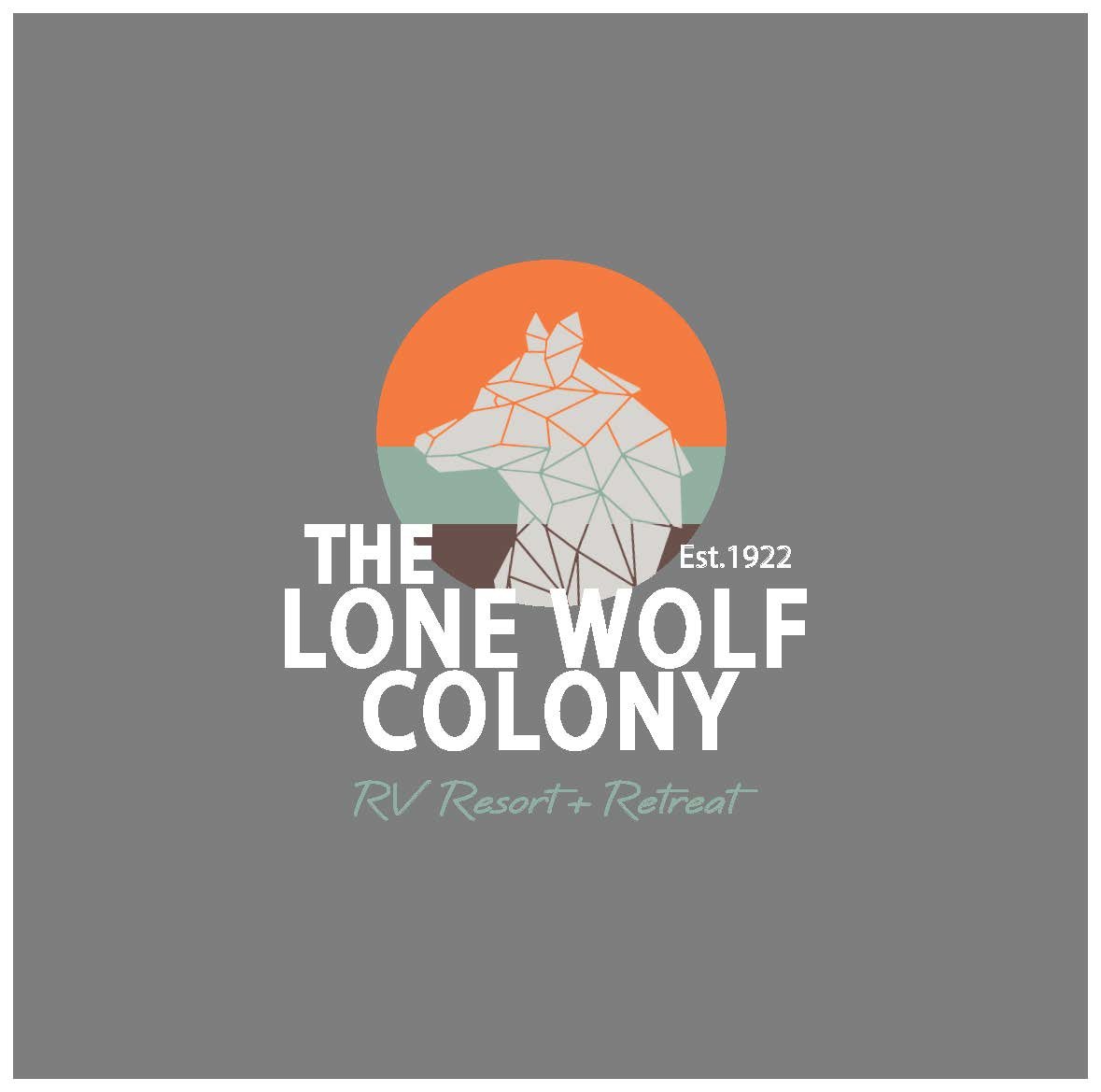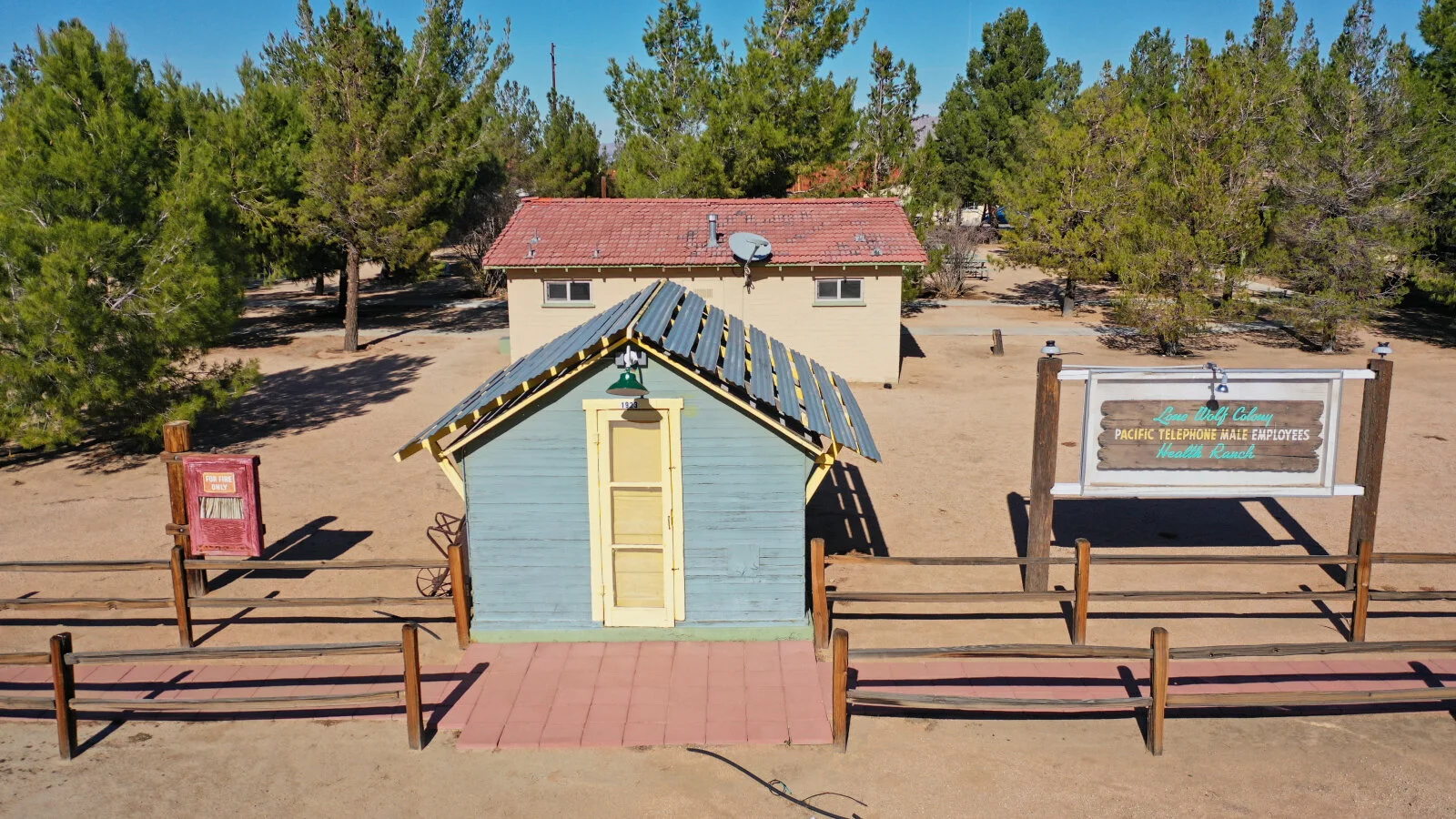Lone Wolf Colony History
During World War I (1914-1918), over 15 million people were killed and a countless number of people injured. Many of these deaths and injuries were due to the use of poison gas as a weapon. Some of the Pacific Telephone and Telegraph employees returning from having served in the armed forces during World War I had suffered from the affects of poison gas and were unable to obtain hospitalization or other care needed. A committee from the Engineering Department of the Southern California Telephone Company (a subsidiary of Pacific Telephone & Telegraph) in Los Angeles began procuring care and lodging for the convalescing men.
Samuel Caldwell, an employee of Southern California Telephone Company in Los Angeles, was diagnosed with tuberculosis shortly after World War I. After he completed treatment, he was advised he needed to convalesce in a dry climate for an extended period of time. Samuel, heeding this advice, filed a homestead claim on 160 acres in the Mojave Desert at Dry Lake Flats, one of the driest climates in California.
Samuel Caldwell 1922
Samuel, short of funds, was aware he would be living on this property for an extended indefinite period of time and needed a plan for the future. Samuel and many of his co-workers had worked for the Home Telephone and Telegraph Company in Los Angeles prior to merging with Southern California Telephone Company; they were a close knit group. In 1917, Samuel shared an idea with his co-workers. He suggested the property, with minimal development, could be a place where other telephone company men with lung disorders could convalesce; a health ranch. He offered his property and property rights with the stipulation he be allowed to stay and be supported during his convalescence. Samuel’s co-workers agreed to the idea and then he and his co-workers began to promote the idea of a health ranch for employees within the company.
Samuel’s initial supporters, mainly employees from outside plant groups, raised funds and a small building (which has been documented as a “shack”) was built on the property. Samuel and a fellow tuberculosis sufferer, Frances Weisenborn, stayed in this cabin (Weisenborn remained at Lone Wolf Colony for a record 656 days).
Samuel and his supporters realized to be taken seriously and to legitimately conduct business, they needed to establish an organization. On October 20, 1922, Samuel and 22 of his supporters held a meeting at the Company personnel office at 309 East Eighth St. in Los Angeles where it was decided to establish and select a board of 20 directors, incorporate the organization, and plan for the future. Samuel had begun calling himself “Chief Lone Wolf” and he proposed the organization name the health ranch “Lone Wolf Colony”, which everyone agreed to. The recorded minutes of the meeting are titled: Mr. W. H. Fairbanks, Pres., Chief Lone Wolf Colony, Los Angeles, California.
The committee from the Engineering Department of the Southern California Telephone Company in Los Angeles that had been procuring care and lodging for the convalescing men from World War I continued until the spring of 1923 when construction began on the first small building at Lone Wolf Colony. Plans for construction of the first small building began in March 1923. Company carpenters donated their services and assembled and stored the construction material in a Company garage. In April, the Company shipped the construction material to the Dry Lake Flats property. After construction on the building was completed, it was decided the water supply at the location was inadequate so the Board began searching for a new location. In April 1923, the Board purchased 10 acres of land for $300. The property was located on the north side of Bear Valley Road about ¼ mile east of Interstate 15 in the Victor Valley. Volunteers moved the building from the Dry Lake Flats property to the new location. A second cabin was purchased for $60.00 and moved to the new location. More guests than anticipated began to arrive, so it was necessary to add 5 individual tent cabins.
Lone Wolf Colony was isolated. Public transportation did not exist and there were no neighbors close by. Groceries, necessities, miscellaneous supplies, water, and ice were delivered to Lone Wolf Colony from Victorville 5 miles away. A radio was purchased, but once delivered and plugged in the guests discovered there were no radio stations within range. The Board purchased a 1915 Model T touring car from the Company’s surplus stock for $17.00. The car made life at Lone Wolf Colony a little easier and with the ability to get around the guests felt less isolated.
The Board received the official incorporation documents dated February 7, 1924. Lone Wolf Colony was in business.
As more men arrived as guests, new problems arose. Each guest was required to prepare his own food, so the meals were not always nutritious nor the best for convalescing men. This prompted the Board to hire a cook around 1925.There were no rules or guidelines which resulted in difficulty in trying to enforce any type of rules or scheduling of chores and activities. The Board decided they would need to write the rules and guidelines for a stay at Lone Wolf Colony and would have to hire a Lone Wolf Colony manager to make sure the rules and guidelines were followed.
Lone Wolf Colony began to grow. In the 3rd year of operation at the second location, the water supply on the property became inadequate. The Board decided to look for a 3rd site with a water supply that would be adequate for current and future needs.
The present 20 acre location, about 12 miles from Victorville, was selected and purchased for $65.00 per acre using a $5,000 grant from Pacific Telephone and Telegraph. The remainder of the grant was used to drill a well and purchase construction and gardening supplies. Sunday, February 28, 1926 was the scheduled date for the move to the new location. On Saturday before the move, employee volunteers began to arrive. 250-275 Company employees volunteered their time to move Lone Wolf Colony to the new location. The majority of volunteers were from the Plant Department in Los Angeles. By sundown on Sunday, all the buildings had been moved to the new site, ditches had been dug, and 5,000 feet of water pipe had been laid (1,800 feet was to a neighbor’s ranch to “borrow” water until the well came in). Linemen in the group built over 2 miles of pole line to add power from the Southern Sierra Power Company to the site. The volunteers also built several hundred feet of fence, dug the reservoir, erected a water tank, planted trees, and graded the driveways and walkways. In addition to the construction, volunteers cooked and served meals to the group of 250-275 men for 2 days. The Los Angeles area General Plant Manager wrote of the move, “The spirit with which the employees put over this project was not only magnificent, but was indicative of the interest they have in Lone Wolf Colony.”
Original Cabin
Lone Wolf Colony continued to grow in size and gain recognition. Articles were published in commercial and telephone industry publications praising the health benefits and the unique character of Lone Wolf Colony. An article in the April 1926 edition of Hollywood Magazine stated “Lone Wolf Colony has become one of the most successful of health institutions.”
Although Lone Wolf Colony continued to prosper and grow, there had been no telephone service due to the isolated location. On May 5, 1927, the Interstate Telegraph Company (now Verizon) completed a request for a telephone line to Lone Wolf Colony. A quote from one of the historical books reads “Aside from a plentiful supply of water, perhaps no other event in the history of the Colony carried the impact of telephone service. No longer were guests cut off from their families and the administration of the affairs of the Colony was improved dramatically.” Lone Wolf Colony was now connected to the world.
By 1930, Lone Wolf Colony had facilities for 10 guests, a permanent caretaker/cook, a mule, goats, chickens, an abundant water supply, and a telephone. Lone Wolf Colony had come a long way from the “shack” at the original location.
Throughout the Lone Wolf Colony’s existence through present day, funds have been of major importance. The first funds were raised at Spring Smokers held in the American Legion Stadium in Hollywood. The Board held an annual fundraiser each spring bringing in funds. The Company made regular monthly monetary contributions. Many monetary contributions came from individuals and employee associations within the company. In 1925, operators partnering with the Local Operator’s School in Los Angeles raised $325.00 through fundraising efforts such as candy sales. In 1925, operators were “women only” making $11.00 per week and were not allowed to stay at Lone Wolf Colony as it was for “men only”. This donation, one of the largest received, reflects employee commitment to making Lone Wolf Colony a success. The first donation from the Southern California Chapter of the Telephone Pioneers of America was $.50; yet Telephone Pioneers became one of Lone Wolf Colony’s strongest supporters. Monetary contributions and volunteers from various Contel, General Telephone, AT&T, and community organizations and groups created the necessary support to maintain and improve the colony throughout the years.
Today, Lone Wolf Colony continues to grow and improve with the help of volunteers from telephone company affiliated and non-telephone company affiliated organizations and groups. Lone Wolf Colony supports and serves the communities in the surrounding area as well as supporting many projects from various organizations and groups. It has grown and become much more, much larger than Samuel Caldwell’s original idea of a health ranch. Samuel, the founder of Lone Wolf Colony, could not have realized his dream without the help, caring, support, and co-operation of his friends, co-workers, employer, and community. There has been a lot of work that has gone into Lone Wolf Colony by many caring, loving, and hard-working people throughout the years to the present time to make it what it is today. This makes Lone Wolf Colony a very special place and visitors and guests can’t help feeling that when they visit.
Lone Wolf Colony 2019





